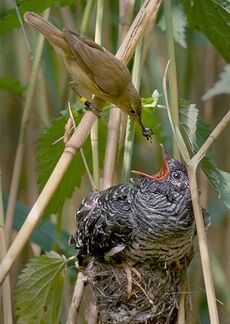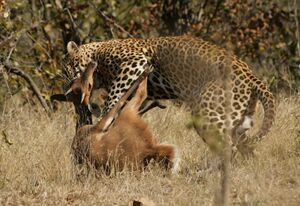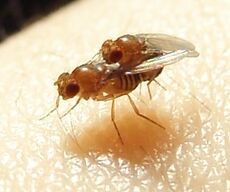“共同演化”的版本间的差异
| 第106行: | 第106行: | ||
到目前为止,所列出的共同进化类型被描述为是两两运作的(也称为特定共同进化) ,其中一个物种的特征是直接响应第二个物种的特征而进化的,反之亦然。但事实并非总是如此。另一种进化模式出现在进化是相互的,但是是在一组物种之间而不是两个物种之间。这被称为公会或漫反射共同进化。例如,几种开花植物的一个特征,例如在长管的末端提供花蜜,可以与一种或几种传粉昆虫的特征共同进化,例如长喙。更一般地说,被子植物是由来自不同科的昆虫授粉的,包括蜜蜂、苍蝇和甲虫,所有这些昆虫形成了一个广泛的授粉者协会,它们对花朵产生的花蜜或花粉作出反应。朱恩格、托马斯和乔伊 · 贝尔格森。成对自然选择与扩散自然选择以及猩红吉利亚的多种食草动物——绿芽菜(Ipomopsis aggregata)进化(1998) : 1583-1592。 | 到目前为止,所列出的共同进化类型被描述为是两两运作的(也称为特定共同进化) ,其中一个物种的特征是直接响应第二个物种的特征而进化的,反之亦然。但事实并非总是如此。另一种进化模式出现在进化是相互的,但是是在一组物种之间而不是两个物种之间。这被称为公会或漫反射共同进化。例如,几种开花植物的一个特征,例如在长管的末端提供花蜜,可以与一种或几种传粉昆虫的特征共同进化,例如长喙。更一般地说,被子植物是由来自不同科的昆虫授粉的,包括蜜蜂、苍蝇和甲虫,所有这些昆虫形成了一个广泛的授粉者协会,它们对花朵产生的花蜜或花粉作出反应。朱恩格、托马斯和乔伊 · 贝尔格森。成对自然选择与扩散自然选择以及猩红吉利亚的多种食草动物——绿芽菜(Ipomopsis aggregata)进化(1998) : 1583-1592。 | ||
| + | |||
| + | |||
| + | == Geographic mosaic theory == | ||
| + | {{main|Mosaic coevolution}} | ||
| + | |||
| + | The geographic mosaic theory of coevolution was developed by [[John N. Thompson]] as a way of linking the ecological and evolutionary processes that shape interactions among species across ecosystems. It is based on three observations that are taken as assumptions: (1) species are usually groups of populations that are somewhat genetically distinct from each other, (2) interacting species often co-occur in only parts of their geographic ranges, and (3) interactions among species differ ecologically among environments. | ||
| + | |||
| + | The geographic mosaic theory of coevolution was developed by John N. Thompson as a way of linking the ecological and evolutionary processes that shape interactions among species across ecosystems. It is based on three observations that are taken as assumptions: (1) species are usually groups of populations that are somewhat genetically distinct from each other, (2) interacting species often co-occur in only parts of their geographic ranges, and (3) interactions among species differ ecologically among environments. | ||
| + | |||
| + | 共同进化的地理镶嵌理论是由约翰 · n · 汤普森发展起来的,作为一种连接生态和进化过程的方式,塑造了生态系统中物种之间的相互作用。它是基于三个观察假设: (1)物种通常是群体的有些基因不同,(2)相互作用的物种经常共生在他们的地理范围的一部分,和(3)物种之间的相互作用在生态上不同的环境。 | ||
| + | |||
| + | From these assumptions, geographic mosaic theory suggests that natural selection on interactions among species is driven by three sources of variation: | ||
| + | |||
| + | From these assumptions, geographic mosaic theory suggests that natural selection on interactions among species is driven by three sources of variation: | ||
| + | |||
| + | 根据这些假设,地理镶嵌理论表明物种间相互作用的自然选择是由三个变异来源驱动的: | ||
| + | |||
| + | 1. ''Geographic selection mosaics'' occur in interactions among species, because genes are expressed in different ways in different environments and because different genes are favored in different environments. For example, natural selection on an interaction between a parasite population and a host population may differ between very dry environments and very wet environments. Alternatively, an interaction between two or more species may be antagonistic in some environments but mutualistic (beneficial to both or all species) in other environments. | ||
| + | |||
| + | 1. Geographic selection mosaics occur in interactions among species, because genes are expressed in different ways in different environments and because different genes are favored in different environments. For example, natural selection on an interaction between a parasite population and a host population may differ between very dry environments and very wet environments. Alternatively, an interaction between two or more species may be antagonistic in some environments but mutualistic (beneficial to both or all species) in other environments. | ||
| + | |||
| + | 1.地理选择马赛克发生在物种之间的相互作用,因为基因在不同的环境中以不同的方式表达,因为不同的基因在不同的环境中受欢迎。例如,寄生虫种群和宿主种群相互作用的自然选择在非常干燥的环境和非常湿润的环境之间可能有所不同。或者,两个或两个以上物种之间的相互作用在某些环境中可能是对抗性的,但在其他环境中是互惠性的(对两个或所有物种都有益)。 | ||
| + | |||
| + | 2. ''Coevolutionary hotspots and coldspots'' occur because natural selection on interactions among species is reciprocal in some environments but not in others. For example, a symbiont population may decrease the survival or reproduction of its hosts in one environment, but it may have no effect on host survival or reproduction in another environment. When detrimental, natural selection will favor evolutionary responses in the host population, resulting in a coevolutionary hotspot of ongoing reciprocal evolutionary changes in the parasite and host populations. When the symbiont has no effect on the survival and reproduction of the host, natural selection on the symbiont population will not favor an evolutionary response by the host population (i.e, a coevolutionary coldspot). | ||
| + | |||
| + | 2. Coevolutionary hotspots and coldspots occur because natural selection on interactions among species is reciprocal in some environments but not in others. For example, a symbiont population may decrease the survival or reproduction of its hosts in one environment, but it may have no effect on host survival or reproduction in another environment. When detrimental, natural selection will favor evolutionary responses in the host population, resulting in a coevolutionary hotspot of ongoing reciprocal evolutionary changes in the parasite and host populations. When the symbiont has no effect on the survival and reproduction of the host, natural selection on the symbiont population will not favor an evolutionary response by the host population (i.e, a coevolutionary coldspot). | ||
| + | |||
| + | 2.共同进化热点和冷点的出现是因为物种间相互作用的自然选择在某些环境中是相互的,而在其他环境中则不然。例如,一个共生生物种群可能会减少其宿主在一个环境中的生存或繁殖,但它可能对宿主在另一个环境中的生存或繁殖没有影响。当有害时,自然选择将有利于宿主种群的进化反应,从而导致寄生虫和宿主种群中正在进行的相互进化变化的共同进化热点。当共生生物对宿主的生存和繁殖没有影响时,共生生物种群的自然选择不利于宿主种群的进化反应(即共同进化的冷斑)。 | ||
| + | |||
| + | 3. Finally, there is constant ''remixing of the traits'' on which natural selection acts both locally and regionally. At any moment in time, a local population will have a unique combination of genes on which natural selection acts. These genetic differences among populations occur because each local population has a unique history of new mutations, genomic alterations (e.g., whole genome duplications), gene flow among populations from individuals arriving from other populations or going to other populations, random loss or fixation of genes at times when populations are small (random genetic drift), hybridization with other species, and other genetic and ecological processes that affect the raw genetic material on which natural selection acts. More formally, then, the geographic mosaic of coevolution can be viewed as a genotype by genotype by environment interaction (GxGxE) that results in the relentless evolution of interacting species. | ||
| + | |||
| + | 3. Finally, there is constant remixing of the traits on which natural selection acts both locally and regionally. At any moment in time, a local population will have a unique combination of genes on which natural selection acts. These genetic differences among populations occur because each local population has a unique history of new mutations, genomic alterations (e.g., whole genome duplications), gene flow among populations from individuals arriving from other populations or going to other populations, random loss or fixation of genes at times when populations are small (random genetic drift), hybridization with other species, and other genetic and ecological processes that affect the raw genetic material on which natural selection acts. More formally, then, the geographic mosaic of coevolution can be viewed as a genotype by genotype by environment interaction (GxGxE) that results in the relentless evolution of interacting species. | ||
| + | |||
| + | 3.最后,自然选择在局部和区域两方面作用的特征不断重新混合。在任何时候,当地的种群都会有一个独特的基因组合,自然选择对其起作用。这些种群之间的遗传差异之所以会出现,是因为每个当地种群都有新突变、基因组改变(例如全基因组复制)、来自其他种群或前往其他种群的个体的种群之间的基因流动、在种群较小时随机丢失或固定基因(随机遗传漂变)、与其他种群杂交,以及影响自然选择作用的原始遗传物质的其他遗传和生态过程。更正式地说,共同进化的地理拼图可以被看作是一种基因型与环境相互作用(GxGxE) ,这种作用导致了相互作用物种的无情进化。 | ||
| + | |||
| + | Geographic mosaic theory has been explored through a wide range of mathematical models, studies of interacting species in nature, and laboratory experiments using microbial species and viruses.<ref name="Thompson, John N. 2005"/><ref name="Thompson, John N"/> | ||
| + | |||
| + | Geographic mosaic theory has been explored through a wide range of mathematical models, studies of interacting species in nature, and laboratory experiments using microbial species and viruses. | ||
| + | |||
| + | 地理镶嵌理论已经通过广泛的数学模型,研究自然界中相互作用的物种,以及使用微生物物种和病毒的实验室实验得到探索。 | ||
| + | |||
| + | ==Outside biology== | ||
| + | Coevolution is primarily a biological concept, but has been applied to other fields by analogy. | ||
| + | |||
| + | Coevolution is primarily a biological concept, but has been applied to other fields by analogy. | ||
| + | |||
| + | 共同进化主要是一个生物学概念,但已类推应用于其他领域。 | ||
| + | |||
| + | ===In algorithms=== | ||
| + | {{See also|Evolutionary computation}} | ||
| + | |||
| + | Coevolutionary algorithms are used for generating [[artificial life]] as well as for optimization, game learning and [[machine learning]].<ref>Potter M. and K. De Jong, Evolving Complex Structures via Cooperative Coevolution, Fourth Annual Conference on Evolutionary Programming, San Diego, CA, 1995.</ref><ref>Potter M., The Design and Computational Model of Cooperative Coevolution, PhD thesis, George Mason University, Fairfax, Virginia, 1997.</ref><ref>{{cite journal|last1=Potter|first1=Mitchell A.|last2=De Jong|first2=Kenneth A.|title=Cooperative Coevolution: An Architecture for Evolving Coadapted Subcomponents|journal=Evolutionary Computation|date=2000|volume=8|issue=1|pages=1–29|doi=10.1162/106365600568086|pmid=10753229|citeseerx=10.1.1.134.2926|s2cid=10265380}}</ref><ref>Weigand P., Liles W., De Jong K., An empirical analysis of collaboration methods in cooperative coevolutionary algorithms. Proceedings of the Genetic and Evolutionary Computation Conference (GECCO) 2001.</ref><ref>Weigand P., An Analysis of Cooperative Coevolutionary Algorithms, PhD thesis, George Mason University, Fairfax, Virginia, 2003.</ref> [[Daniel Hillis]] added "co-evolving parasites" to prevent an optimization procedure from becoming stuck at local maxima.<ref>{{citation |author=Hillis, W.D. |year=1990 |title=Co-evolving parasites improve simulated evolution as an optimization procedure |journal=Physica D: Nonlinear Phenomena |volume=42 |issue=1–3 |pages=228–234 |doi=10.1016/0167-2789(90)90076-2|bibcode=1990PhyD...42..228H}}</ref> [[Karl Sims]] coevolved virtual creatures.<ref>{{cite web|last1=Sims |first1=Karl |title=Evolved Virtual Creatures |url=http://www.karlsims.com/evolved-virtual-creatures.html|publisher=Karl Sims|access-date=17 January 2017|date=1994}}</ref> | ||
| + | |||
| + | Coevolutionary algorithms are used for generating artificial life as well as for optimization, game learning and machine learning.Potter M. and K. De Jong, Evolving Complex Structures via Cooperative Coevolution, Fourth Annual Conference on Evolutionary Programming, San Diego, CA, 1995.Potter M., The Design and Computational Model of Cooperative Coevolution, PhD thesis, George Mason University, Fairfax, Virginia, 1997.Weigand P., Liles W., De Jong K., An empirical analysis of collaboration methods in cooperative coevolutionary algorithms. Proceedings of the Genetic and Evolutionary Computation Conference (GECCO) 2001.Weigand P., An Analysis of Cooperative Coevolutionary Algorithms, PhD thesis, George Mason University, Fairfax, Virginia, 2003. Daniel Hillis added "co-evolving parasites" to prevent an optimization procedure from becoming stuck at local maxima. Karl Sims coevolved virtual creatures. | ||
| + | |||
| + | 协同进化算法用于生成人工生命,以及优化,博弈学习和机器学习。和 k. De Jong,通过合作共同进化进化复杂结构,第四届进化规划年会,圣地亚哥,加利福尼亚州,1995。合作共同进化的设计与计算模型,博士论文,乔治梅森大学,费尔法克斯,弗吉尼亚州,1997。合作共同进化算法中协作方法的实证分析。2001年遗传学和进化计算学会会议论文集。合作共同进化算法分析》 ,博士论文,乔治梅森大学,弗吉尼亚州费尔法克斯,2003年。Daniel Hillis 补充了“共同进化寄生虫”,以防止优化过程陷入局部极大值。卡尔 · 西姆斯共同进化了虚拟生物。 | ||
2022年1月9日 (日) 14:21的版本
Fig reproduction and fig wasps
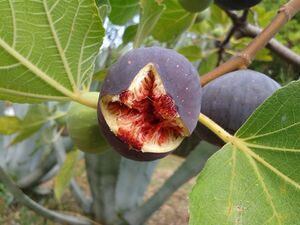
The genus Ficus is composed of 800 species of vines, shrubs, and trees, including the cultivated fig, defined by their syconiums, the fruit-like vessels that either hold female flowers or pollen on the inside. Each fig species has its own fig wasp which (in most cases) pollinates the fig, so a tight mutual dependence has evolved and persisted throughout the genus.[1]
The genus Ficus is composed of 800 species of vines, shrubs, and trees, including the cultivated fig, defined by their syconiums, the fruit-like vessels that either hold female flowers or pollen on the inside. Each fig species has its own fig wasp which (in most cases) pollinates the fig, so a tight mutual dependence has evolved and persisted throughout the genus.
榕属植物由800种藤本植物、灌木和乔木组成,其中包括栽培的无花果。每一种榕树都有自己的榕小蜂(在大多数情况下)为榕小蜂授粉,所以这个属中形成了一种紧密的相互依赖关系。
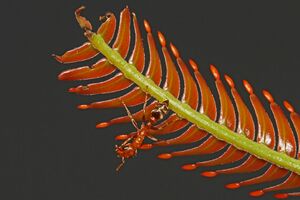
Acacia ants and acacias
Acacia ants and acacias
= = 相思蚂蚁和金合欢 =
The acacia ant (Pseudomyrmex ferruginea) is an obligate plant ant that protects at least five species of "Acacia" (Vachellia)模板:Efn from preying insects and from other plants competing for sunlight, and the tree provides nourishment and shelter for the ant and its larvae.[2][3] Such mutualism is not automatic: other ant species exploit trees without reciprocating, following different evolutionary strategies. These cheater ants impose important host costs via damage to tree reproductive organs, though their net effect on host fitness is not necessarily negative and, thus, becomes difficult to forecast.[4][5]
The acacia ant (Pseudomyrmex ferruginea) is an obligate plant ant that protects at least five species of "Acacia" (Vachellia) from preying insects and from other plants competing for sunlight, and the tree provides nourishment and shelter for the ant and its larvae. Such mutualism is not automatic: other ant species exploit trees without reciprocating, following different evolutionary strategies. These cheater ants impose important host costs via damage to tree reproductive organs, though their net effect on host fitness is not necessarily negative and, thus, becomes difficult to forecast.
金合欢蚂蚁(相思树蚁)是一种专性植物蚂蚁,它能保护至少5种金合欢树(Vachellia)免受捕食昆虫和其他植物争夺阳光的伤害,并为蚂蚁及其幼虫提供营养和庇护。这种互利共生并不是自然而然的: 其他蚂蚁种类遵循不同的进化策略,不作回报地利用树木。这些骗子蚂蚁通过破坏树木的生殖器官给寄主造成重大损失,但它们对寄主适合度的净影响并不一定是负面的,因此难以预测。
Hosts and parasites
Parasites and sexually reproducing hosts
Host–parasite coevolution is the coevolution of a host and a parasite.[6] A general characteristic of many viruses, as obligate parasites, is that they coevolved alongside their respective hosts. Correlated mutations between the two species enter them into an evolution arms race. Whichever organism, host or parasite, that cannot keep up with the other will be eliminated from their habitat, as the species with the higher average population fitness survives. This race is known as the Red Queen hypothesis.[7] The Red Queen hypothesis predicts that sexual reproduction allows a host to stay just ahead of its parasite, similar to the Red Queen's race in Through the Looking-Glass: "it takes all the running you can do, to keep in the same place".[8] The host reproduces sexually, producing some offspring with immunity over its parasite, which then evolves in response.[9]
Host–parasite coevolution is the coevolution of a host and a parasite. A general characteristic of many viruses, as obligate parasites, is that they coevolved alongside their respective hosts. Correlated mutations between the two species enter them into an evolution arms race. Whichever organism, host or parasite, that cannot keep up with the other will be eliminated from their habitat, as the species with the higher average population fitness survives. This race is known as the Red Queen hypothesis. cited in: The Red Queen Principle The Red Queen hypothesis predicts that sexual reproduction allows a host to stay just ahead of its parasite, similar to the Red Queen's race in Through the Looking-Glass: "it takes all the running you can do, to keep in the same place". The host reproduces sexually, producing some offspring with immunity over its parasite, which then evolves in response.
= = = 寄生虫和有性生殖的宿主 = = = 宿主-寄生虫的共同进化是宿主和寄生虫的共同进化。许多病毒作为专性寄生虫的一个普遍特征是它们与各自的宿主共同进化。这两个物种之间的相关突变使它们进入了进化的军备竞赛。无论是哪种生物、宿主或寄生物,如果不能跟上其他生物的步伐,就会从它们的栖息地消失,因为平均适合度较高的物种会幸存下来。这一种族被称为红皇后假说。红皇后原则红皇后假说预测有性生殖可以让寄主在寄生虫之前保持领先,就像爱丽丝镜中奇遇的红皇后比赛一样: “你可以尽你所能地跑,保持在同一个地方。”。宿主进行有性繁殖,产生一些对寄生虫具有免疫力的后代,然后进化为应对措施。
The parasite–host relationship probably drove the prevalence of sexual reproduction over the more efficient asexual reproduction. It seems that when a parasite infects a host, sexual reproduction affords a better chance of developing resistance (through variation in the next generation), giving sexual reproduction variability for fitness not seen in the asexual reproduction, which produces another generation of the organism susceptible to infection by the same parasite.[10][11][12] Coevolution between host and parasite may accordingly be responsible for much of the genetic diversity seen in normal populations, including blood-plasma polymorphism, protein polymorphism, and histocompatibility systems.[13]
The parasite–host relationship probably drove the prevalence of sexual reproduction over the more efficient asexual reproduction. It seems that when a parasite infects a host, sexual reproduction affords a better chance of developing resistance (through variation in the next generation), giving sexual reproduction variability for fitness not seen in the asexual reproduction, which produces another generation of the organism susceptible to infection by the same parasite. Coevolution between host and parasite may accordingly be responsible for much of the genetic diversity seen in normal populations, including blood-plasma polymorphism, protein polymorphism, and histocompatibility systems.
寄生虫与宿主的关系可能导致了有性生殖的流行,而不是更有效率的无性生殖。看起来,当寄生虫感染宿主时,有性生殖提供了一个更好的机会来发展抗药性(通过下一代的变异) ,使得适应性的有性生殖变异性在无性生殖中看不到,这就产生了另一代的有机体,易受同一寄生虫的感染。宿主和寄生虫之间的共同进化可能相应地导致了正常人群中的许多遗传多样性,包括血浆多态性、蛋白多态性和组织相容性系统。
Brood parasites
Brood parasitism demonstrates close coevolution of host and parasite, for example in some cuckoos. These birds do not make their own nests, but lay their eggs in nests of other species, ejecting or killing the eggs and young of the host and thus having a strong negative impact on the host's reproductive fitness. Their eggs are camouflaged as eggs of their hosts, implying that hosts can distinguish their own eggs from those of intruders and are in an evolutionary arms race with the cuckoo between camouflage and recognition. Cuckoos are counter-adapted to host defences with features such as thickened eggshells, shorter incubation (so their young hatch first), and flat backs adapted to lift eggs out of the nest.[14][15][16]
Brood parasitism demonstrates close coevolution of host and parasite, for example in some cuckoos. These birds do not make their own nests, but lay their eggs in nests of other species, ejecting or killing the eggs and young of the host and thus having a strong negative impact on the host's reproductive fitness. Their eggs are camouflaged as eggs of their hosts, implying that hosts can distinguish their own eggs from those of intruders and are in an evolutionary arms race with the cuckoo between camouflage and recognition. Cuckoos are counter-adapted to host defences with features such as thickened eggshells, shorter incubation (so their young hatch first), and flat backs adapted to lift eggs out of the nest.
巢寄生证明了宿主和寄生虫的密切共同进化,例如在一些杜鹃中。这些鸟不自己筑巢,而是在其他物种的巢中产卵,排出或杀死寄主的卵和幼鸟,从而对寄主的生殖适应性产生严重的负面影响。它们的卵伪装成它们寄主的卵,这意味着寄主能够区分自己的卵和入侵者的卵,并且处于一种进化的军备竞赛中,杜鹃介于伪装和识别之间。杜鹃与寄主相反,具有加厚的蛋壳、较短的孵化期(所以它们的幼鸟先孵化)以及适于将蛋提出巢外的平背等特征。
Antagonistic coevolution
Antagonistic coevolution
= = 对抗性共同进化 =
Antagonistic coevolution is seen in the harvester ant species Pogonomyrmex barbatus and Pogonomyrmex rugosus, in a relationship both parasitic and mutualistic. The queens are unable to produce worker ants by mating with their own species. Only by crossbreeding can they produce workers. The winged females act as parasites for the males of the other species as their sperm will only produce sterile hybrids. But because the colonies are fully dependent on these hybrids to survive, it is also mutualistic. While there is no genetic exchange between the species, they are unable to evolve in a direction where they become too genetically different as this would make crossbreeding impossible.[17]
Antagonistic coevolution is seen in the harvester ant species Pogonomyrmex barbatus and Pogonomyrmex rugosus, in a relationship both parasitic and mutualistic. The queens are unable to produce worker ants by mating with their own species. Only by crossbreeding can they produce workers. The winged females act as parasites for the males of the other species as their sperm will only produce sterile hybrids. But because the colonies are fully dependent on these hybrids to survive, it is also mutualistic. While there is no genetic exchange between the species, they are unable to evolve in a direction where they become too genetically different as this would make crossbreeding impossible.
拮抗性的共同进化在收获蚂蚁种类 Pogonomyrmex barbatus 和 Pogonomyrmex rugosus 中可以看到,它们之间既有寄生关系也有互惠关系。蚁后无法通过与同类交配来繁殖工蚁。只有通过杂交,他们才能生产工人。有翅膀的雌性像寄生虫一样为其他物种的雄性服务,因为它们的精子只会产生不育的杂种。但由于殖民地完全依赖这些杂交种生存,这也是互惠互利的。虽然两个物种之间没有基因交换,但它们无法朝着基因差异太大的方向进化,因为这将使杂交繁殖变得不可能。
Predators and prey
Predators and prey interact and coevolve: the predator to catch the prey more effectively, the prey to escape. The coevolution of the two mutually imposes selective pressures. These often lead to an evolutionary arms race between prey and predator, resulting in anti-predator adaptations.[18]
Predators and prey interact and coevolve: the predator to catch the prey more effectively, the prey to escape. The coevolution of the two mutually imposes selective pressures. These often lead to an evolutionary arms race between prey and predator, resulting in anti-predator adaptations.
捕食者和猎物相互作用并共同进化: 捕食者更有效地捕捉猎物,猎物逃跑。两者的共同进化相互施加选择压力。这往往导致进化的军备竞赛之间的猎物和捕食者,导致反捕食适应。
The same applies to herbivores, animals that eat plants, and the plants that they eat. Paul R. Ehrlich and Peter H. Raven in 1964 proposed the theory of escape and radiate coevolution to describe the evolutionary diversification of plants and butterflies.[19] In the Rocky Mountains, red squirrels and crossbills (seed-eating birds) compete for seeds of the lodgepole pine. The squirrels get at pine seeds by gnawing through the cone scales, whereas the crossbills get at the seeds by extracting them with their unusual crossed mandibles. In areas where there are squirrels, the lodgepole's cones are heavier, and have fewer seeds and thinner scales, making it more difficult for squirrels to get at the seeds. Conversely, where there are crossbills but no squirrels, the cones are lighter in construction, but have thicker scales, making it more difficult for crossbills to get at the seeds. The lodgepole's cones are in an evolutionary arms race with the two kinds of herbivore.[20]
The same applies to herbivores, animals that eat plants, and the plants that they eat. Paul R. Ehrlich and Peter H. Raven in 1964 proposed the theory of escape and radiate coevolution to describe the evolutionary diversification of plants and butterflies. In the Rocky Mountains, red squirrels and crossbills (seed-eating birds) compete for seeds of the lodgepole pine. The squirrels get at pine seeds by gnawing through the cone scales, whereas the crossbills get at the seeds by extracting them with their unusual crossed mandibles. In areas where there are squirrels, the lodgepole's cones are heavier, and have fewer seeds and thinner scales, making it more difficult for squirrels to get at the seeds. Conversely, where there are crossbills but no squirrels, the cones are lighter in construction, but have thicker scales, making it more difficult for crossbills to get at the seeds. The lodgepole's cones are in an evolutionary arms race with the two kinds of herbivore. and the two following pages of the web article.
这同样适用于食草动物,吃植物的动物,以及它们吃的植物。1964年,Paul r. Ehrlich 和 Peter h. Raven 提出了逃逸辐射共同进化理论来描述植物和蝴蝶的进化多样性。在落基山脉,红松鼠和斑鸠(食种子的鸟)争夺海滩松的种子。松鼠通过啃咬松果鳞片来获取松子,而交喙则通过它们不寻常的交叉下颚来获取松子。在有松鼠的地方,海滩鱼的球果更重,种子更少,鳞片更薄,这使得松鼠更难获得种子。相反,如果有交喙,但没有松鼠,球果的结构较轻,但有较厚的鳞片,使交喙更难以获得种子。海滩上的锥形细胞与这两种食草动物进行着一场进化中的军备竞赛。以及接下来两页的网络文章。
Competition
Both intraspecific competition, with features such as sexual conflict[21] and sexual selection,[22] and interspecific competition, such as between predators, may be able to drive coevolution.[23]
Both intraspecific competition, with features such as sexual conflict and sexual selection, and interspecific competition, such as between predators, may be able to drive coevolution.
无论是具有如性冲突和性选择等特征的种内竞争,还是具有如食肉动物之间的种间竞争,都可能推动共同进化。
Multispecies
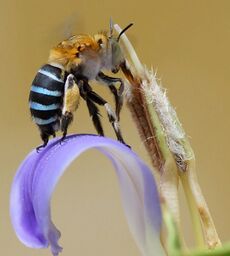
thumb|upright|Long-tongued bees and long-tubed flowers coevolved, whether pairwise or "diffusely" in groups known as guilds.
多种蜂和长舌蜜蜂共同进化,不论是成对的还是“广泛”进化的,都被称为公会。
The types of coevolution listed so far have been described as if they operated pairwise (also called specific coevolution), in which traits of one species have evolved in direct response to traits of a second species, and vice versa. This is not always the case. Another evolutionary mode arises where evolution is reciprocal, but is among a group of species rather than exactly two. This is variously called guild or diffuse coevolution. For instance, a trait in several species of flowering plant, such as offering its nectar at the end of a long tube, can coevolve with a trait in one or several species of pollinating insects, such as a long proboscis. More generally, flowering plants are pollinated by insects from different families including bees, flies, and beetles, all of which form a broad guild of pollinators which respond to the nectar or pollen produced by flowers.[24][25][26]
The types of coevolution listed so far have been described as if they operated pairwise (also called specific coevolution), in which traits of one species have evolved in direct response to traits of a second species, and vice versa. This is not always the case. Another evolutionary mode arises where evolution is reciprocal, but is among a group of species rather than exactly two. This is variously called guild or diffuse coevolution. For instance, a trait in several species of flowering plant, such as offering its nectar at the end of a long tube, can coevolve with a trait in one or several species of pollinating insects, such as a long proboscis. More generally, flowering plants are pollinated by insects from different families including bees, flies, and beetles, all of which form a broad guild of pollinators which respond to the nectar or pollen produced by flowers.Juenger, Thomas, and Joy Bergelson. "Pairwise versus diffuse natural selection and the multiple herbivores of scarlet gilia, Ipomopsis aggregata." Evolution (1998): 1583–1592.
到目前为止,所列出的共同进化类型被描述为是两两运作的(也称为特定共同进化) ,其中一个物种的特征是直接响应第二个物种的特征而进化的,反之亦然。但事实并非总是如此。另一种进化模式出现在进化是相互的,但是是在一组物种之间而不是两个物种之间。这被称为公会或漫反射共同进化。例如,几种开花植物的一个特征,例如在长管的末端提供花蜜,可以与一种或几种传粉昆虫的特征共同进化,例如长喙。更一般地说,被子植物是由来自不同科的昆虫授粉的,包括蜜蜂、苍蝇和甲虫,所有这些昆虫形成了一个广泛的授粉者协会,它们对花朵产生的花蜜或花粉作出反应。朱恩格、托马斯和乔伊 · 贝尔格森。成对自然选择与扩散自然选择以及猩红吉利亚的多种食草动物——绿芽菜(Ipomopsis aggregata)进化(1998) : 1583-1592。
Geographic mosaic theory
The geographic mosaic theory of coevolution was developed by John N. Thompson as a way of linking the ecological and evolutionary processes that shape interactions among species across ecosystems. It is based on three observations that are taken as assumptions: (1) species are usually groups of populations that are somewhat genetically distinct from each other, (2) interacting species often co-occur in only parts of their geographic ranges, and (3) interactions among species differ ecologically among environments.
The geographic mosaic theory of coevolution was developed by John N. Thompson as a way of linking the ecological and evolutionary processes that shape interactions among species across ecosystems. It is based on three observations that are taken as assumptions: (1) species are usually groups of populations that are somewhat genetically distinct from each other, (2) interacting species often co-occur in only parts of their geographic ranges, and (3) interactions among species differ ecologically among environments.
共同进化的地理镶嵌理论是由约翰 · n · 汤普森发展起来的,作为一种连接生态和进化过程的方式,塑造了生态系统中物种之间的相互作用。它是基于三个观察假设: (1)物种通常是群体的有些基因不同,(2)相互作用的物种经常共生在他们的地理范围的一部分,和(3)物种之间的相互作用在生态上不同的环境。
From these assumptions, geographic mosaic theory suggests that natural selection on interactions among species is driven by three sources of variation:
From these assumptions, geographic mosaic theory suggests that natural selection on interactions among species is driven by three sources of variation:
根据这些假设,地理镶嵌理论表明物种间相互作用的自然选择是由三个变异来源驱动的:
1. Geographic selection mosaics occur in interactions among species, because genes are expressed in different ways in different environments and because different genes are favored in different environments. For example, natural selection on an interaction between a parasite population and a host population may differ between very dry environments and very wet environments. Alternatively, an interaction between two or more species may be antagonistic in some environments but mutualistic (beneficial to both or all species) in other environments.
1. Geographic selection mosaics occur in interactions among species, because genes are expressed in different ways in different environments and because different genes are favored in different environments. For example, natural selection on an interaction between a parasite population and a host population may differ between very dry environments and very wet environments. Alternatively, an interaction between two or more species may be antagonistic in some environments but mutualistic (beneficial to both or all species) in other environments.
1.地理选择马赛克发生在物种之间的相互作用,因为基因在不同的环境中以不同的方式表达,因为不同的基因在不同的环境中受欢迎。例如,寄生虫种群和宿主种群相互作用的自然选择在非常干燥的环境和非常湿润的环境之间可能有所不同。或者,两个或两个以上物种之间的相互作用在某些环境中可能是对抗性的,但在其他环境中是互惠性的(对两个或所有物种都有益)。
2. Coevolutionary hotspots and coldspots occur because natural selection on interactions among species is reciprocal in some environments but not in others. For example, a symbiont population may decrease the survival or reproduction of its hosts in one environment, but it may have no effect on host survival or reproduction in another environment. When detrimental, natural selection will favor evolutionary responses in the host population, resulting in a coevolutionary hotspot of ongoing reciprocal evolutionary changes in the parasite and host populations. When the symbiont has no effect on the survival and reproduction of the host, natural selection on the symbiont population will not favor an evolutionary response by the host population (i.e, a coevolutionary coldspot).
2. Coevolutionary hotspots and coldspots occur because natural selection on interactions among species is reciprocal in some environments but not in others. For example, a symbiont population may decrease the survival or reproduction of its hosts in one environment, but it may have no effect on host survival or reproduction in another environment. When detrimental, natural selection will favor evolutionary responses in the host population, resulting in a coevolutionary hotspot of ongoing reciprocal evolutionary changes in the parasite and host populations. When the symbiont has no effect on the survival and reproduction of the host, natural selection on the symbiont population will not favor an evolutionary response by the host population (i.e, a coevolutionary coldspot).
2.共同进化热点和冷点的出现是因为物种间相互作用的自然选择在某些环境中是相互的,而在其他环境中则不然。例如,一个共生生物种群可能会减少其宿主在一个环境中的生存或繁殖,但它可能对宿主在另一个环境中的生存或繁殖没有影响。当有害时,自然选择将有利于宿主种群的进化反应,从而导致寄生虫和宿主种群中正在进行的相互进化变化的共同进化热点。当共生生物对宿主的生存和繁殖没有影响时,共生生物种群的自然选择不利于宿主种群的进化反应(即共同进化的冷斑)。
3. Finally, there is constant remixing of the traits on which natural selection acts both locally and regionally. At any moment in time, a local population will have a unique combination of genes on which natural selection acts. These genetic differences among populations occur because each local population has a unique history of new mutations, genomic alterations (e.g., whole genome duplications), gene flow among populations from individuals arriving from other populations or going to other populations, random loss or fixation of genes at times when populations are small (random genetic drift), hybridization with other species, and other genetic and ecological processes that affect the raw genetic material on which natural selection acts. More formally, then, the geographic mosaic of coevolution can be viewed as a genotype by genotype by environment interaction (GxGxE) that results in the relentless evolution of interacting species.
3. Finally, there is constant remixing of the traits on which natural selection acts both locally and regionally. At any moment in time, a local population will have a unique combination of genes on which natural selection acts. These genetic differences among populations occur because each local population has a unique history of new mutations, genomic alterations (e.g., whole genome duplications), gene flow among populations from individuals arriving from other populations or going to other populations, random loss or fixation of genes at times when populations are small (random genetic drift), hybridization with other species, and other genetic and ecological processes that affect the raw genetic material on which natural selection acts. More formally, then, the geographic mosaic of coevolution can be viewed as a genotype by genotype by environment interaction (GxGxE) that results in the relentless evolution of interacting species.
3.最后,自然选择在局部和区域两方面作用的特征不断重新混合。在任何时候,当地的种群都会有一个独特的基因组合,自然选择对其起作用。这些种群之间的遗传差异之所以会出现,是因为每个当地种群都有新突变、基因组改变(例如全基因组复制)、来自其他种群或前往其他种群的个体的种群之间的基因流动、在种群较小时随机丢失或固定基因(随机遗传漂变)、与其他种群杂交,以及影响自然选择作用的原始遗传物质的其他遗传和生态过程。更正式地说,共同进化的地理拼图可以被看作是一种基因型与环境相互作用(GxGxE) ,这种作用导致了相互作用物种的无情进化。
Geographic mosaic theory has been explored through a wide range of mathematical models, studies of interacting species in nature, and laboratory experiments using microbial species and viruses.[27][28]
Geographic mosaic theory has been explored through a wide range of mathematical models, studies of interacting species in nature, and laboratory experiments using microbial species and viruses.
地理镶嵌理论已经通过广泛的数学模型,研究自然界中相互作用的物种,以及使用微生物物种和病毒的实验室实验得到探索。
Outside biology
Coevolution is primarily a biological concept, but has been applied to other fields by analogy.
Coevolution is primarily a biological concept, but has been applied to other fields by analogy.
共同进化主要是一个生物学概念,但已类推应用于其他领域。
In algorithms
Coevolutionary algorithms are used for generating artificial life as well as for optimization, game learning and machine learning.[29][30][31][32][33] Daniel Hillis added "co-evolving parasites" to prevent an optimization procedure from becoming stuck at local maxima.[34] Karl Sims coevolved virtual creatures.[35]
Coevolutionary algorithms are used for generating artificial life as well as for optimization, game learning and machine learning.Potter M. and K. De Jong, Evolving Complex Structures via Cooperative Coevolution, Fourth Annual Conference on Evolutionary Programming, San Diego, CA, 1995.Potter M., The Design and Computational Model of Cooperative Coevolution, PhD thesis, George Mason University, Fairfax, Virginia, 1997.Weigand P., Liles W., De Jong K., An empirical analysis of collaboration methods in cooperative coevolutionary algorithms. Proceedings of the Genetic and Evolutionary Computation Conference (GECCO) 2001.Weigand P., An Analysis of Cooperative Coevolutionary Algorithms, PhD thesis, George Mason University, Fairfax, Virginia, 2003. Daniel Hillis added "co-evolving parasites" to prevent an optimization procedure from becoming stuck at local maxima. Karl Sims coevolved virtual creatures.
协同进化算法用于生成人工生命,以及优化,博弈学习和机器学习。和 k. De Jong,通过合作共同进化进化复杂结构,第四届进化规划年会,圣地亚哥,加利福尼亚州,1995。合作共同进化的设计与计算模型,博士论文,乔治梅森大学,费尔法克斯,弗吉尼亚州,1997。合作共同进化算法中协作方法的实证分析。2001年遗传学和进化计算学会会议论文集。合作共同进化算法分析》 ,博士论文,乔治梅森大学,弗吉尼亚州费尔法克斯,2003年。Daniel Hillis 补充了“共同进化寄生虫”,以防止优化过程陷入局部极大值。卡尔 · 西姆斯共同进化了虚拟生物。
- ↑ 1.0 1.1 Suleman, Nazia; Sait, Steve; Compton, Stephen G. (2015). "Female figs as traps: Their impact on the dynamics of an experimental fig tree-pollinator-parasitoid community" (PDF). Acta Oecologica. 62: 1–9. Bibcode:2015AcO....62....1S. doi:10.1016/j.actao.2014.11.001.
- ↑ 2.0 2.1 Hölldobler, Bert; Wilson, Edward O. (1990). The ants. Harvard University Press. pp. 532–533. ISBN 978-0-674-04075-5. https://archive.org/details/ants0000hlld.
- ↑ National Geographic. "Acacia Ant Video". Archived from the original on 2007-11-07.
- ↑ Palmer TM, Doak DF, Stanton ML, Bronstein JL, Kiers ET, Young TP, Goheen JR, Pringle RM (2010). "Synergy of multiple partners, including freeloaders, increases host fitness in a multispecies mutualism". Proceedings of the National Academy of Sciences of the United States of America. 107 (40): 17234–9. Bibcode:2010PNAS..10717234P. doi:10.1073/pnas.1006872107. PMC 2951420. PMID 20855614.
- ↑ Mintzer, Alex; Vinson, S.B. (1985). "Kinship and incompatibility between colonies of the acacia ant Pseudomyrex ferruginea". Behavioral Ecology and Sociobiology. 17 (1): 75–78. doi:10.1007/bf00299432. JSTOR 4599807. S2CID 9538185.
- ↑ Woolhouse, M. E. J.; Webster, J. P.; Domingo, E.; Charlesworth, B.; Levin, B. R. (December 2002). "Biological and biomedical implications of the coevolution of pathogens and their hosts" (PDF). Nature Genetics. 32 (4): 569–77. doi:10.1038/ng1202-569. hdl:1842/689. PMID 12457190. S2CID 33145462.
- ↑ Van Valen, L. (1973). "A New Evolutionary Law". Evolutionary Theory. 1: 1–30. cited in: The Red Queen Principle
- ↑ Carroll, Lewis (1875). Through the Looking-glass: And what Alice Found There. Macmillan. p. 42. https://books.google.com/books?id=cJJZAAAAYAAJ. "it takes all the running you can do, to keep in the same place."
- ↑ Rabajante, J.; et al. (2015). "Red Queen dynamics in multi-host and multi-parasite interaction system". Scientific Reports. 5: 10004. Bibcode:2015NatSR...510004R. doi:10.1038/srep10004. PMC 4405699. PMID 25899168.
- ↑ "Sexual reproduction works thanks to ever-evolving host, parasite relationships". PhysOrg. 7 July 2011.
- ↑ Morran, L.T.; Schmidt, O.G.; Gelarden, I.A.; Parrish, R.C. II; Lively, C.M. (8 July 2011). "Running with the Red Queen: Host-Parasite Coevolution Selects for Biparental Sex". Science. 333 (6039): 216–8. Bibcode:2011Sci...333..216M. doi:10.1126/science.1206360. PMC 3402160. PMID 21737739. Science.1206360.
- ↑ Hogan, C. Michael (2010). "Virus". In Cutler Cleveland; Sidney Draggan (eds.). Encyclopedia of Earth.
- ↑ Anderson, R.; May, R. (October 1982). "Coevolution of hosts and parasites". Parasitology. 85 (2): 411–426. doi:10.1017/S0031182000055360. PMID 6755367.
- ↑ 14.0 14.1 Weiblen, George D. (May 2003). "Interspecific Coevolution" (PDF). Macmillan.
- ↑ Rothstein, S.I (1990). "A model system for coevolution: avian brood parasitism". Annual Review of Ecology and Systematics. 21: 481–508. doi:10.1146/annurev.ecolsys.21.1.481.
- ↑ Davies, N. B. (Nicholas B.), 1952- (7 April 2015). Cuckoo : cheating by nature. McCallum, James (Wildlife artist) (First U.S. ed.). New York, NY. ISBN 978-1-62040-952-7. OCLC 881092849.
- ↑ Herrmann, M.; Cahan, S. H. (29 October 2014). "Inter-genomic sexual conflict drives antagonistic coevolution in harvester ants". Proceedings of the Royal Society B: Biological Sciences. 281 (1797): 20141771. doi:10.1098/rspb.2014.1771. PMC 4240986. PMID 25355474.
- ↑ "Predator-Prey Relationships". New England Complex Systems Institute. Retrieved 17 January 2017.
- ↑ Ehrlich, Paul R.; Raven, Peter H. (1964). "Butterflies and Plants: A Study in Coevolution". Evolution. 18 (4): 586–608. doi:10.2307/2406212. JSTOR 2406212.
- ↑ "Coevolution". University of California Berkeley. Retrieved 17 January 2017. and the two following pages of the web article.
- ↑ Parker, G. A. (2006). "Sexual conflict over mating and fertilization: An overview". Philosophical Transactions of the Royal Society B: Biological Sciences. 361 (1466): 235–59. doi:10.1098/rstb.2005.1785. PMC 1569603. PMID 16612884.
- ↑ "Biol 2007 - Coevolution". University College, London. Retrieved 19 January 2017.
- ↑ Connell, Joseph H. (October 1980). "Diversity and the Coevolution of Competitors, or the Ghost of Competition Past". Oikos. 35 (2): 131–138. doi:10.2307/3544421. JSTOR 3544421. S2CID 5576868.
- ↑ 24.0 24.1 Juenger, Thomas, and Joy Bergelson. "Pairwise versus diffuse natural selection and the multiple herbivores of scarlet gilia, Ipomopsis aggregata." Evolution (1998): 1583–1592.
- ↑ Gullan, P. J.; Cranston, P. S. (2010). The Insects: An Outline of Entomology (4th ed.). Wiley. pp. 291–293. ISBN 978-1-118-84615-5. https://archive.org/details/insectsoutlineen00pjgu.
- ↑ Rader, Romina; Bartomeus, Ignasi; et al. (2016). "Non-bee insects are important contributors to global crop pollination". PNAS. 113 (1): 146–151. Bibcode:2016PNAS..113..146R. doi:10.1073/pnas.1517092112. PMC 4711867. PMID 26621730.
- ↑ 引用错误:无效
<ref>标签;未给name属性为Thompson, John N. 2005的引用提供文字 - ↑ 引用错误:无效
<ref>标签;未给name属性为Thompson, John N的引用提供文字 - ↑ Potter M. and K. De Jong, Evolving Complex Structures via Cooperative Coevolution, Fourth Annual Conference on Evolutionary Programming, San Diego, CA, 1995.
- ↑ Potter M., The Design and Computational Model of Cooperative Coevolution, PhD thesis, George Mason University, Fairfax, Virginia, 1997.
- ↑ Potter, Mitchell A.; De Jong, Kenneth A. (2000). "Cooperative Coevolution: An Architecture for Evolving Coadapted Subcomponents". Evolutionary Computation. 8 (1): 1–29. CiteSeerX 10.1.1.134.2926. doi:10.1162/106365600568086. PMID 10753229. S2CID 10265380.
- ↑ Weigand P., Liles W., De Jong K., An empirical analysis of collaboration methods in cooperative coevolutionary algorithms. Proceedings of the Genetic and Evolutionary Computation Conference (GECCO) 2001.
- ↑ Weigand P., An Analysis of Cooperative Coevolutionary Algorithms, PhD thesis, George Mason University, Fairfax, Virginia, 2003.
- ↑ Hillis, W.D. (1990), "Co-evolving parasites improve simulated evolution as an optimization procedure", Physica D: Nonlinear Phenomena, 42 (1–3): 228–234, Bibcode:1990PhyD...42..228H, doi:10.1016/0167-2789(90)90076-2
- ↑ Sims, Karl (1994). "Evolved Virtual Creatures". Karl Sims. Retrieved 17 January 2017.
